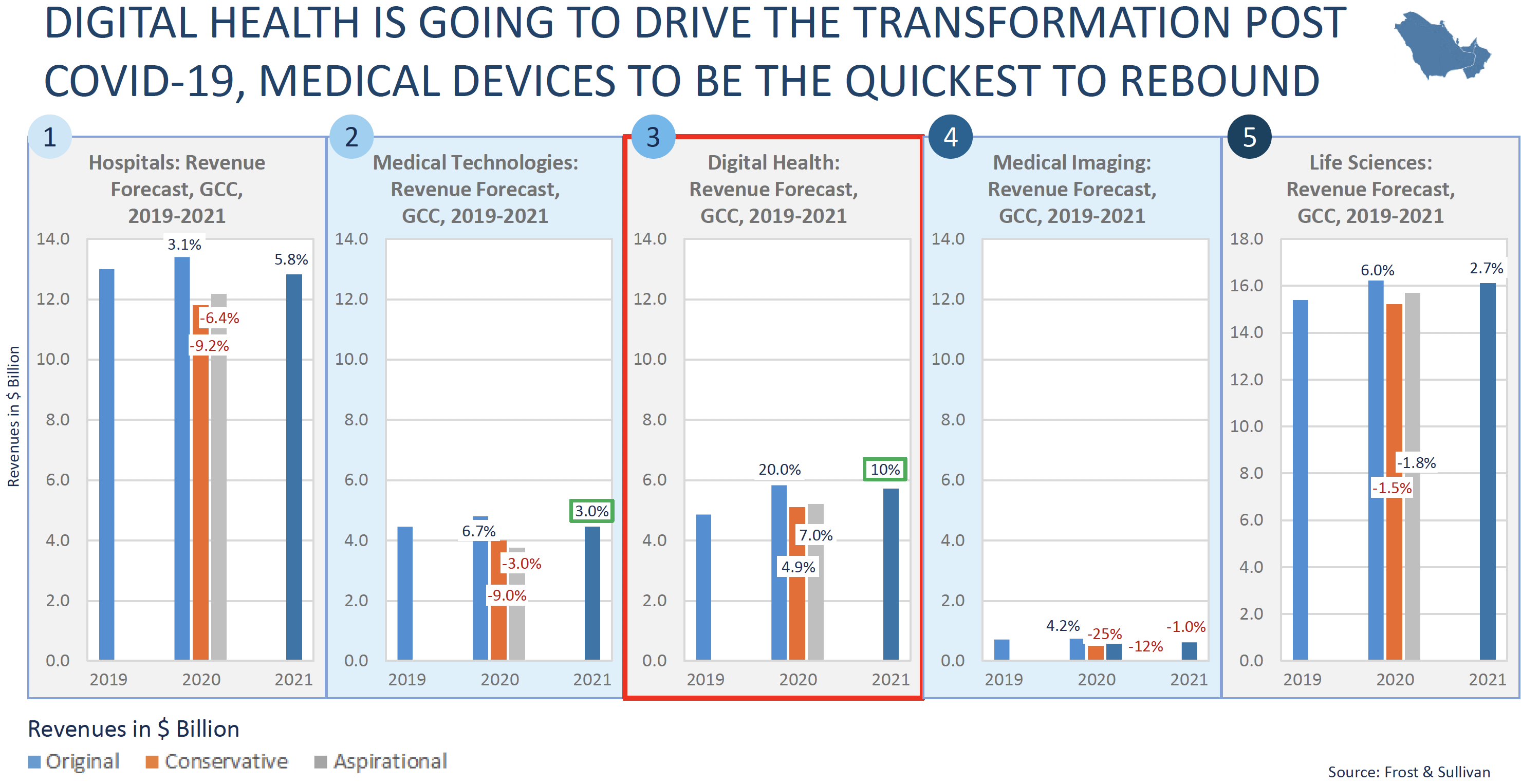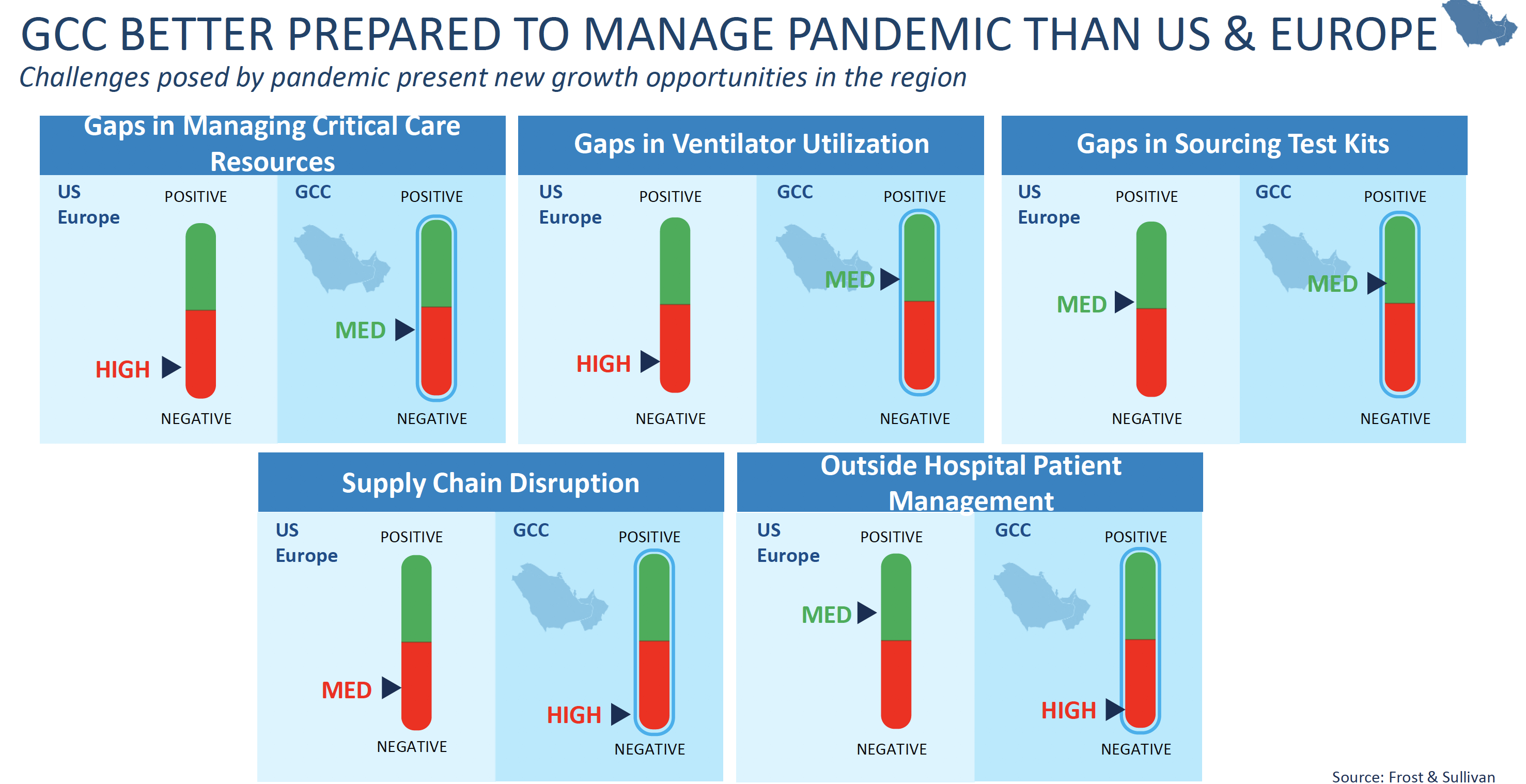The total GCC healthcare market was estimated to be US$38.5 billion in 2019. Frost & Sullivan had originally forecasted it to become US$41.1 billion in 2020. However, post COVID-19, the market dynamics have changed significantly, and the current projections highlight that the market will reportedly witness a -2 per cent growth rate in 2020 and reach US$38.5 billion. In 2021, the market is expected to grow by 1 per cent and reach US$39.7 billion.
Omnia Health Insights spoke to Reenita Das, Transformational Healthcare Senior Vice President and Partner at Frost & Sullivan, who discussed the current trends being witnessed in the GCC healthcare market and how the region has tackled challenges as compared to the West.
Recent findings from Frost & Sullivan highlighted that Pacific China is already in the recovery stage and things are normalising in most places. But on the other hand, in the U.S. and Europe, the rate of recovery is still quite slow.
Das said: “We're looking at recovery only getting into positive GDP next year in quarter one, making this year pretty dismal for those two parts of the world. However, in the Middle East, the recovery has been steadier and will get better primarily by the end of 2020.”

Unfortunately, hospitals have taken a hard hit – their cash flow and liquidity are some of the major concerns, said Das. “The market is going to slow down this year by almost negative nine per cent and might come into shape in 2021 getting close to where it was in 2019. So, if you think about the hospital market in the GCC, it is going to be slow and then go up next year,” she explained.
For private hospitals, orthopaedic procedures are big-ticket items and for now, it has stopped. Also, infection control measures have not been the best since the pandemic started, which has led to staff being infected and there are not enough healthcare workers to treat because of that.
Digital health

Das highlighted that while the medical technologies market has also seen a slump, projections estimate that it will see a three per cent increase in growth next year. Also, the pharmaceutical industry is witnessing growth thanks to the demand for diagnostics.
According to Das, one of the worst-hit areas has been the medical imaging market. The reason for this is largely because elective procedures have stopped and there is less demand for the equipment. However, post-COVID-19 the demand is going to surge again, and hospitals might not be able to manage the workload. This will lead to an emerging trend in the future where hospitals will frequently collaborate with health tech companies.
“We feel that there's going to be a lot of radiologist burnout and interpretation of skills might be affected in the way that they are looking at the data,” she added. “This is where teleradiology will play a key role as it will help to increase volume and procedures during the rebound time, as it will make more use of digital tools such as AI and informatics.”
Comparison between U.S. and GCC markets
Digital health is forecasted to grow by next year to around 10 per cent due to the investment that needs to happen in terms of telehealth due to COVID-19. The growth rate in the U.S. for telehealth is 66 per cent. Reportedly, telehealth visits have gone up by 200 per cent in the last one month in the country.
Das explained that in order to see how the GCC has fared compared to the U.S. and Europe, the first thing is to look at gaps in managing critical care market resources. “We find that in terms of this, the GCC has not had it as bad,” she said. “For example, KSA and the other countries have a large focus on critical care beds in rural centres compared to the U.S. Because of that they're being able to access the population much quicker.”
Another area of comparison is ventilators and their utilisation and availability. “The U.S. has an install base of only 80,000 ventilators. Unfortunately, right now, the demand is half a million – it’s a huge deficit. The advantage GCC countries have is that 60 to 70 per cent of the patients who are admitted to the hospital require some form of ventilator support.
Therefore, I think their ability to satisfy ventilator needs are much higher than others. The region has also done a great job when it comes to testing,” she highlighted.

However, she said that the areas that the GCC has not done well is supply chain. This can be attributed to the fact that the region is a big importer when it comes to medical equipment.
Another area is building the infrastructure outside the hospital. In the region, everything is done in the hospital and as a result, it's become a big bottleneck for the GCC countries. The home is still not considered to be a testing site in the region. This has led to a huge volume of patients who need help but cannot get access and have to go to hospitals for everything. But due to the fear of catching the infection, no one wants to visit hospitals, and this might affect possible revenues. “I think that the business model has to change. In the future, this would definitely be a good way to look at how countries are performing when compared to other parts of the world,” she added.
With overstretched resources and not being able to support chronic disease patients, there is an urgent need to build infrastructure outside the hospital. Frost & Sullivan projects that by next year, 20 per cent of patients will start doing some form of virtual visits in the KSA and UAE.
Moreover, Frost & Sullivan predicts that virtual visits in the GCC are set to increase by 14 per cent. Also, the clinical decision support tools and remote patient monitoring will be a US$3 billion market by 2021 in the region.

Reenita Das
COVID-19 Growth opportunities
Das shared that there are three big growth opportunities for the GCC region. These include virtual care solutions such as telehealth, remote patient monitoring and wearables.
“These are three big markets for investment that organisations should look at. For instance, the whole concept of a waiting room is going to change in the future and how can the industry look at that as an opportunity. Also, how can they create an ICU command centre and do telly ICU monitoring? That's another big area where investment needs to be.”
She said that this is termed as the hub and spoke model. The heart is going to be the centre of the hospital and the scope models revolve around it. For instance, whether it's surgeries, mental health clinics, geriatric services, etc., there needs to be more drive around digital technologies.
“The reality of the day is that digitisation needs to happen. If we are not doing it there's going to be no way that hospitals are going to survive in the future.”
Nonetheless, in terms of digital health, there has been a lack of digital infrastructure policy and framework. Telemedicine still very weak, in part, due to cybersecurity threats that continued to rise last year. The biggest challenge today is how to build that framework. How do you create policies that enable patients to access their records and see people through a video call? Those systems have to work, in India for example, telehealth and video visits have increased dramatically. Also, countries such as Germany, Australia, UK, have all set these developments in motion.
The GCC countries have invested a lot in digital health on hospitals, be it in terms of administrative or clinical IT. With the onset of COVID-19, the region has also invested in terms of remote monitoring, telehealth and wearables. Das shared that now they need to focus on building infrastructure for the management of chronic diseases effectively through these technologies.
Impact on life sciences
In the GCC, there has been a dip in the in vitro diagnostic testing market due to COVID-19. Also, people with chronic diseases who were previously having tests done every one or two months have stopped getting these done. Moreover, clinical trials have also stopped completely.
A recent finding by Frost & Sullivan found that in the UAE and KSA alone prescriptions had decreased by 8 million, which means that these patients are not adhering to their prescriptions and might end up facing serious issues in the future.
However, one of the biggest growth opportunities for the industry will be in point of care testing.
In conclusion, she said: “I would say this has been a watershed moment for the healthcare industry. In my view, COVID-19 has changed healthcare forever. It's almost like we had a war. But unlike a regular war, it was calm and sharp, so we don't even know who our enemy is. When it comes to vaccines and treatments, the whole global scientific community has come together and is working very hard.
“However, it's also shown us that the current system is inadequate to cope with any emergency or adversity. It's shown us that we need help from outside the industry and healthcare companies cannot do this alone. We need help in terms of digital transformation. Therefore, we need companies from outside that are the experts to come in, as they will be able to transform the industry much faster.”


